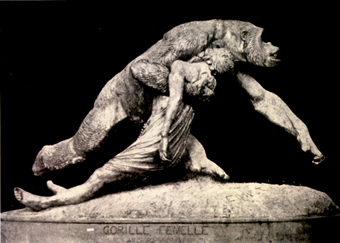
Emmanuel Frémiet - Gorille enlevant une negresse (1859)
"In 1859, the French sculptor Emmanuel Frémiet (1824-1910) alarmed the jury of the Paris Salon by submitting a greater than life-size plaster composition, Gorille enlevant une negresse (Gorilla Carrying off a Negress). The jury found it to be too confronting for both its graphic violence and for its proximity to current debates about evolution. In that same year, Charles Darwin had published On the Origin of Species by Means of Natural Selection, a work that acted as a flashpoint for evolutionary theory. For decades prior to the appearance of Darwin's landmark text, scientists and theologians struggled to reconcile a barrage of new discoveries in the fields of archaeology, geology and comparative anatomy with traditionally held beliefs concerning the world's and humanity's creation.
By 1859 Frémiet had already established a national and international reputation as a master sculptor. He had caught the imagination of visitors to the annual Paris Salon in 1843 with his life-size plaster sculptures of both wild and domestic animals that were astonishing for their faithfulness to nature and lifelike qualities. Frémiet’s three-dimensional evocations of domestic pets proved especially popular in his early career, bringing him increasing critical acclaim and the financial reward of official patronage. He seemed, however, to have seriously blotted his copybook with the Gorilla Carrying off a Negress, at least in the eyes of the more conservative controllers of the art world. Frémiet himself recalled:
At a time when a lot of noise was being made about mankind and apes being brothers, it was an audacious idea; and my work proved even more aggravating since, the gorilla being the ugliest of all the primates, the comparison was hardly flattering for humans ... The jury's condemnation was unanimous. My work was declared to be seriously offensive to public morality, and it was banished pitilessly from the Salon.
Alfred, Comte de Nieuwerkerke, the chief arts administrator, quickly intervened and a place was found for the artist's sculpture, despite its official rejection from the items accepted into the Salon proper. The Gorilla was installed towards the entrance of the Salon's sculpture section, set back in a niche behind heavy green velvet curtains. While the conservative jury surely hoped to marginalise the work, this special treatment - or maltreatment - served only to create a cause celebre around Frémiet's sculpture. Parting these curtains to obtain a glimpse of the censored work became de rigueur for adult visitors to that year's Salon. According to the artist, women were especially titillated by the piece, whose composition was certainly confronting. The sculpture not only depicted a murder, but also seemed to allude to ravishment, visualising the worst fears of many about the planet's largest and most human-seeming primate. Reading the sculpture in this way, the critic Charles Baudelaire took exception to its subject matter:
Why are we not given a crocodile, a tiger, or any other wild animal that might eat a woman? Because this is not about eating, but rape! It is the ape alone, this gigantic ape at once so much more and less than a man, which has at times shown a human appetite for women ... To be honest, such subjects are beneath the dignity of so talented an artist, and the jury has done well to reject this sordid topic.
It is perhaps not surprising that Gorilla Carrying off a Negress, which was destroyed in 1861 and is now known only from a handful of photographs, was disturbing to viewers in 1859. The gorilla itself was still a newly discovered and much misunderstood species, and this added scientific and speculative weight to the frisson produced by Frémiet's sculpture."
From Clutch of the Beast by Ted Gott